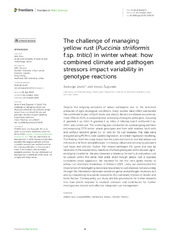Приказ основних података о документу
The challenge of managing yellow rust (Puccinia striiformis f.sp. tritici) in winter wheat: how combined climate and pathogen stressors impact variability in genotype reactions
| dc.creator | Jevtić, Radivoje | |
| dc.creator | Župunski, Vesna | |
| dc.date.accessioned | 2023-10-24T12:33:05Z | |
| dc.date.available | 2023-10-24T12:33:05Z | |
| dc.date.issued | 2023 | |
| dc.identifier.issn | 1664-462X | |
| dc.identifier.uri | http://fiver.ifvcns.rs/handle/123456789/3862 | |
| dc.description.abstract | Despite the ongoing evolution of wheat pathogens due to the selection pressures of agro-ecological conditions, many studies have often overlooked the combined impact of both biotic and abiotic factors on disease occurrence. From 2016 to 2023, a comprehensive screening of obligate pathogens, including B. graminis f. sp. tritici, P. graminis f. sp. tritici, P. triticina, and P. striiformis f. sp. tritici, was carried out. This screening was conducted on a phenotyping platform encompassing 2715 winter wheat genotypes and their wild relatives, both with and without resistant genes (Lr, Yr, and Sr) for rust diseases. The data were analyzed using PCAmix, best subsets regression, and linear regression modeling. The findings from this study reveal that the plant reactions to leaf and yellow rust infections is far from straightforward. It is heavily influenced not only by prevalent rust races and climatic factors that impact pathogen life cycles but also by variations in the susceptibility reactions of wheat genotypes to the broader agro-ecological conditions. We also observed a tendency for leaf rust and yellow rust to coexist within the same host plant, even though yellow rust is typically considered more aggressive. We reported for the first time genes related to yellow rust resistance breakdown in Serbia in 2023. Lastly, we underscored the importance of investigating resistance responses to rust diseases not exclusively through the interrelation between resistance genes and pathogen virulence, but also by considering how plants respond to the combined stresses of abiotic and biotic factors. Consequently, our study sets the groundwork for further research into how plants respond to multiple stressors and contributes for further investigations related with effective integrated rust management. | sr |
| dc.language.iso | en | sr |
| dc.publisher | Frontiers Media S.A. | sr |
| dc.relation | info:eu-repo/grantAgreement/MESTD/inst-2020/200032/RS// | sr |
| dc.rights | openAccess | sr |
| dc.rights.uri | https://creativecommons.org/licenses/by/4.0/ | |
| dc.source | Frontiers in Plant Science | sr |
| dc.subject | yellow rust | sr |
| dc.subject | susceptibility | sr |
| dc.subject | resistance | sr |
| dc.subject | wheat | sr |
| dc.subject | climatic factors | sr |
| dc.subject | Puccinia striiformis f.sp. tritici | sr |
| dc.subject | Puccinia striiformis | sr |
| dc.subject | pathogens | sr |
| dc.subject | variability | sr |
| dc.subject | genotypes | sr |
| dc.title | The challenge of managing yellow rust (Puccinia striiformis f.sp. tritici) in winter wheat: how combined climate and pathogen stressors impact variability in genotype reactions | sr |
| dc.type | article | sr |
| dc.rights.license | BY | sr |
| dc.citation.rank | aM21~ | |
| dc.citation.spage | 1270087 | |
| dc.citation.volume | 14 | |
| dc.identifier.doi | 10.3389/fpls.2023.1270087 | |
| dc.identifier.fulltext | http://fiver.ifvcns.rs/bitstream/id/9652/fpls-14-1270087.pdf | |
| dc.identifier.scopus | 2-s2.0-85175821293 | |
| dc.type.version | publishedVersion | sr |


